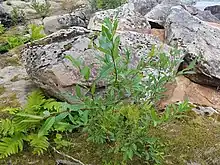| Salix myricoides | |
|---|---|
 | |
| Scientific classification | |
| Kingdom: | Plantae |
| Clade: | Tracheophytes |
| Clade: | Angiosperms |
| Clade: | Eudicots |
| Clade: | Rosids |
| Order: | Malpighiales |
| Family: | Salicaceae |
| Genus: | Salix |
| Species: | S. myricoides |
| Binomial name | |
| Salix myricoides | |
| Synonyms[1] | |
|
List
| |
Salix myricoides, the bayberry willow or blue-leaf willow, is a species of flowering plant in the family Salicaceae, native to the Great Lakes region of the Midwestern United States, and to eastern Canada.[1][2] It is typically found on beaches and dunes of the Lakes, and occasionally along inland streams and in fens, if calcareous.[2] For example, in Maine it is found only on the ice-scoured shore of the St. John River.[3]
References
- 1 2 "Salix myricoides Muhl". Plants of the World Online. Royal Botanic Gardens, Kew. Retrieved 23 September 2022.
- 1 2 Reznicek, A. A.; Voss, E. G.; Walters, B. S. (February 2011). "Salix myricoides Muhl". Michigan Flora Online. University of Michigan. Retrieved 23 September 2022.
- ↑ "Salix myricoides — bayberry willow". Go Botany (3.8). Native Plant Trust. 2022. Retrieved 23 September 2022.
This article is issued from Wikipedia. The text is licensed under Creative Commons - Attribution - Sharealike. Additional terms may apply for the media files.